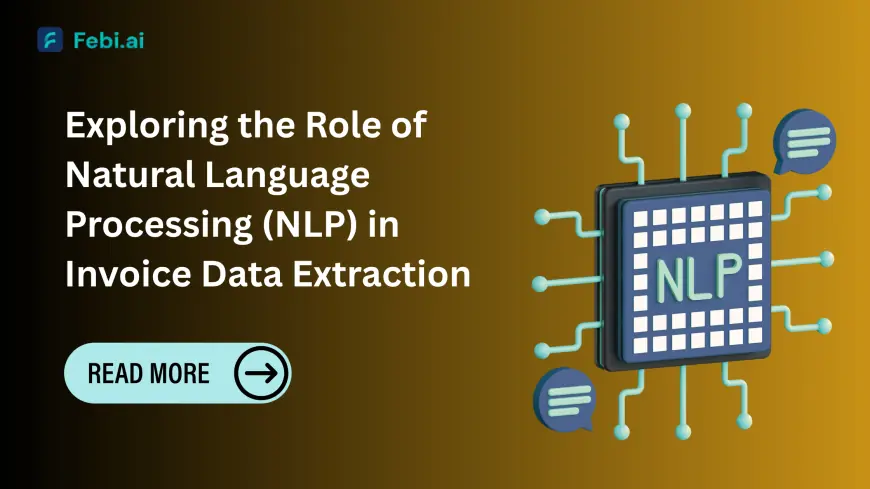Exploring the Role of Natural Language Processing (NLP) in Invoice Data Extraction

In the digital transformation era, where automation drives business efficiency and cost optimization, invoice data extraction stands out as a critical workflow ripe for innovation. Traditionally dependent on manual entry or rigid templates, invoice processing is undergoing a radical evolution — thanks to Natural Language Processing (NLP).
Natural Language Processing, a subset of Artificial Intelligence (AI), enables machines to understand and interpret human language. When applied to financial documents like invoices, NLP can drastically improve accuracy, efficiency, and scalability.
This article delves into how NLP plays a pivotal role in invoice data extraction, exploring its technology underpinnings, practical applications, benefits, and future outlook.
What Is Invoice Data Extraction?
Invoice data extraction refers to the process of identifying and capturing key information from invoice documents — such as:
-
Invoice number
-
Vendor name
-
Invoice date
-
Purchase order (PO) number
-
Line items
-
Total amount
-
Tax/VAT
-
Payment terms
Traditionally, this process involved manual entry or Optical Character Recognition (OCR) combined with rule-based logic. However, invoices are inherently unstructured or semi-structured documents that vary widely in format across vendors, regions, and industries. This variability presents challenges that traditional automation tools struggle to handle efficiently.
That’s where NLP steps in.
Why NLP Matters in Invoice Processing
Unlike OCR, which simply converts images to text, NLP understands the meaning and context of language. For invoices, this means NLP doesn’t just recognize the word "Total" — it understands that it might refer to a monetary value and identifies its relevance based on location, formatting, and surrounding terms.
Here’s how NLP improves invoice data extraction:
-
Semantic Understanding: NLP models can comprehend the semantic structure of an invoice — recognizing that "Subtotal," "Total Due," or even "Grand Amount" might all refer to the same data field.
-
Layout Awareness: With the help of Natural Language Understanding (NLU) and visual layout models, NLP can detect patterns and relationships between text blocks, even in complex table structures.
-
Entity Recognition: NLP enables the system to identify and extract named entities like dates, currencies, quantities, or vendor names, irrespective of how they are formatted or labeled.
-
Language Variability Handling: NLP supports multilingual invoices, abbreviations, and synonyms, which are especially useful in global supply chains.
Key NLP Techniques in Invoice Data Extraction
-
Named Entity Recognition (NER)
NER is an NLP technique used to locate and classify named entities in text into predefined categories like dates, organizations, or monetary values. In invoice extraction, NER helps identify:
-
Vendor names
-
Invoice numbers
-
Payment terms
-
Due dates
-
Currency amounts
-
-
Part-of-Speech (POS) Tagging
This technique involves labeling words with their respective parts of speech (nouns, verbs, adjectives, etc.), helping the system understand the context in which a term is used.
-
Dependency Parsing
This technique maps the relationships between words in a sentence or block of text, helping identify which terms are associated with others (e.g., the “due date” is associated with a specific value).
-
Word Embeddings and Transformers
Pre-trained language models like BERT, RoBERTa, or LayoutLM are now being used in invoice automation tools. These models understand the context of words in both language and document layout, enabling far more accurate extraction than rule-based or template-based systems.
-
Semantic Labeling
NLP algorithms classify different parts of the invoice based on meaning — recognizing that “Invoice Date” and “Date of Issue” are semantically the same.
NLP vs. Traditional Invoice Processing: A Comparison
| Feature | Traditional OCR & Rules | NLP-Driven Extraction |
|---|---|---|
| Template Flexibility | Low | High |
| Language Support | Limited | Multilingual |
| Context Understanding | None | Deep Semantic Understanding |
| Table & Line-Item Extraction | Error-Prone | Accurate with layout models |
| Accuracy in Unstructured Layouts | Low | High |
| Adaptability to New Formats | Manual Configuration |
Self-Learning with AI |
Real-World Applications of NLP in Invoice Processing
1. Accounts Payable Automation
Modern AP software uses NLP to ingest invoices from multiple channels (email, PDF, scans) and accurately extract data for automatic posting into ERP systems — reducing manual workload and error rates.
2. Vendor Onboarding
By applying NLP to supplier-submitted documents, organizations can validate information, verify tax IDs, and pre-fill registration fields — accelerating onboarding workflows.
3. Compliance and Audit
NLP models can automatically detect anomalies, duplicate invoices, or mismatched POs — aiding in fraud detection and compliance monitoring.
4. Contract Matching
Invoices are often matched against purchase orders and contracts. NLP helps in semantic matching of invoice terms with legal or commercial documents to ensure consistency.
Benefits of NLP-Driven Invoice Data Extraction
High Accuracy
By understanding context, NLP reduces false positives and improves precision in field mapping, even in noisy or distorted documents.
Reduced Manual Intervention
With smart classification and validation, finance teams spend less time correcting or validating invoices, freeing up time for strategic tasks.
Faster Processing Times
Invoices can be processed in real-time or near real-time, improving vendor satisfaction and reducing late payment penalties.
Scalability
NLP models can process thousands of invoices daily, scaling up easily without requiring new templates or rules.
Improved Vendor Relationships
Accurate and timely invoice processing ensures vendors are paid correctly and on time — enhancing trust and loyalty.
Challenges and Considerations
Despite its advantages, NLP in invoice processing comes with challenges:
-
Training Data Requirements: High-performing NLP models require large datasets for training, especially across varied invoice formats.
-
Complex Layouts: Some invoices have embedded tables, handwritten notes, or non-standard formatting that may confuse even advanced models.
-
Language Ambiguity: Invoices with inconsistent terminology or poorly scanned text can reduce model confidence.
-
Regulatory Constraints: Financial data handling needs to comply with data privacy regulations like GDPR, adding layers of complexity.
The Future of NLP in Invoice Automation
The future of NLP-powered invoice extraction is being shaped by advancements like:
-
Multimodal Models: Integrating text, layout, and image features (like LayoutLMv3 or DocFormer) for holistic document understanding.
-
Few-Shot and Zero-Shot Learning: Reducing the dependency on large training datasets while enabling rapid adaptation to new formats.
-
Active Learning Loops: Allowing systems to learn from user feedback and improve extraction accuracy over time.
-
Embedded AI in ERPs: Seamless NLP-powered extraction integrated directly into popular ERPs (like SAP, Oracle, NetSuite) for out-of-the-box automation.
Final Thoughts
Natural Language Processing is not just a buzzword in finance automation — it’s a foundational technology reshaping how organizations handle invoice data. By marrying context awareness with layout intelligence, NLP transforms unstructured invoices into clean, structured, actionable data.
As AI models grow more sophisticated and accessible, businesses that embrace NLP-driven invoice extraction will not only reduce operational costs but also enhance agility, compliance, and vendor satisfaction.
In a world where data is gold and speed is power, NLP is the alchemist turning financial paperwork into strategic advantage.
What's Your Reaction?
 Like
0
Like
0
 Dislike
0
Dislike
0
 Love
0
Love
0
 Funny
0
Funny
0
 Angry
0
Angry
0
 Sad
0
Sad
0
 Wow
0
Wow
0


















































